Is your beloved canine companion constantly scratching, biting, or shaking its head? Chances are, fleas have made themselves at home—and they won’t leave quietly. Fleas don’t just cause irritation; they can trigger severe allergic reactions, transmit internal parasites like tapeworms, and rapidly infest your home, turning a minor nuisance into a major problem within days. Fortunately, you don’t always need a prescription to resolve a flea issue.
While powerful vet-prescribed flea treatments are available, they aren’t always necessary, nor are they always the most accessible or affordable option. This is where over-the-counter (OTC) flea medicines come into play. These non-prescription solutions are readily available online and in stores, offering effective relief and routine protection against fleas for many dogs. This comprehensive guide will walk you through everything you need to know about choosing the Best Flea Treatment For Dogs Without A Vet Prescription, from understanding how fleas affect your pet to comparing the top products available today. Whether you’re dealing with a sudden outbreak or simply aiming for reliable monthly prevention, this article has you covered. It’s crucial to address flea problems promptly to prevent discomfort and potential health complications for your dog, and sometimes, alleviating stress from persistent itching might involve offering them a calming treat for dogs alongside treatment.
📌 TL;DR: Top OTC Flea Treatment for Dogs (2025)
- Fleas cause intense itching, allergic reactions, and secondary infections—prompt action is essential.
- Effective OTC options like Frontline Plus, Capstar, and Seresto are available without a vet prescription.
- Select the best treatment based on your dog’s age, weight, health status, and exposure risk to fleas and ticks.
- Always adhere to dosage and application instructions meticulously; never combine different treatments unless advised by a vet.
- Natural remedies (such as sprays and diatomaceous earth) are generally more effective for prevention and environmental control rather than active infestations.
- Always consult a veterinarian for puppies, pregnant dogs, senior pets, or cases of severe flea infestation or allergic reactions.
How Do Fleas Affect Dogs and Why Should You Act Fast?
What are fleas and why are they such a problem for dogs?
Fleas are tiny, wingless parasites that survive by feeding on the blood of their hosts. Once they latch onto your dog, they don’t just stay put; they rapidly lay eggs that easily fall off into your carpets, bedding, and furniture. This quickly escalates a simple nuisance into a full-blown home infestation in a matter of days. Their rapid reproductive cycle makes them incredibly challenging to eradicate if not dealt with swiftly and thoroughly.
How can you tell if your dog has fleas?
Vigilance is key to early detection. Watch for these common indicators:
- Persistent scratching, licking, or biting at the skin, particularly around the tail base, groin, and behind the ears.
- Hair loss or the appearance of red, irritated patches (hot spots), especially in areas of intense scratching.
- Flea dirt: These are tiny black specks that resemble ground pepper. If you moisten them on a white paper towel, they’ll turn reddish-brown, indicating digested blood.
- Visible fleas crawling through the fur: Although they are fast and small, you might occasionally spot them, especially if your dog has a lighter coat.
Some dogs, particularly those with sensitivities, may exhibit more severe symptoms such as extreme restlessness, scabbing, or intense allergic reactions like flea allergy dermatitis (FAD).
What are the health risks of fleas on dogs?
Fleas are far more than just annoying; they pose significant health threats:
- Flea allergy dermatitis (FAD): This is the most common skin disease in dogs, triggered by an allergic reaction to flea saliva. Even a few bites can lead to intense itching, redness, hair loss, and skin infections.
- Tapeworms: Fleas can carry the larvae of tapeworms. If a dog accidentally ingests an infected flea (often while grooming itself), it can develop a tapeworm infection, leading to digestive issues and weight loss.
- Anemia: In severe infestations, especially in puppies, small breeds, or older/sick dogs, the continuous blood loss from frequent flea bites can cause anemia, leading to weakness, fatigue, pale gums, and in critical cases, even be life-threatening.
- Skin infections: Constant scratching and biting can break the skin, creating open wounds that are highly susceptible to bacterial infections, often requiring veterinary intervention with antibiotics.
Given how quickly fleas multiply and the range of health problems they can cause, the sooner you act, the better your chances of keeping your dog—and your home—safe, healthy, and itch-free.
Which Flea Treatments Can You Use Without a Vet Prescription?
When it comes to fighting fleas without a prescription, dog owners have a variety of effective options. Over-the-counter (OTC) flea medicines come in several forms, each with its own advantages and ideal uses. The right choice for your dog depends on their lifestyle, sensitivities, the severity of the flea problem, and your personal preference for application. For puppies, it’s worth noting that while flea treatments are crucial, providing good chew options for puppies can also help manage their chewing habits during stressful times, like dealing with an itch.
Flea & Tick Collars
Products like the Seresto Flea Collar are renowned for providing up to 8 months of continuous defense against both fleas and ticks. These collars are often odorless, waterproof, and ideal for pet parents who appreciate the convenience of a “set-it-and-forget-it” solution, eliminating the need for monthly applications.
Best for: Long-term, low-maintenance, year-round protection.
Oral Flea & Tick Control
Oral tablets such as Capstar are designed for rapid action, beginning to kill fleas within just 30 minutes of administration. They are excellent for emergency use when you need to quickly reduce the flea burden on your dog. However, their effect is short-lived, typically lasting only 24 hours, meaning they work best when combined with a longer-term treatment plan.
Best for: Fast-acting relief during active infestations or emergency flare-ups.
Topical Spot-on Flea & Tick Control
Spot-on treatments, including popular brands like Frontline Plus and Advantage II, are applied directly to the dog’s skin, usually between the shoulder blades. They work by spreading over the skin and coat, killing adult fleas, larvae, and eggs on contact or after a bite. These treatments offer up to 30 days of protection, are typically easy to apply, and many are water-resistant, making them suitable for active dogs.
Best for: Monthly prevention and comprehensive full-body protection against fleas and often ticks.
Flea Shampoos & Sprays
Products such as Adams Plus Flea Shampoo and Vet’s Best Flea Spray provide immediate relief by killing fleas on contact. Shampoos can also help soothe irritated skin caused by bites. These options are perfect for an initial cleanup to remove a large number of fleas quickly or as a supplement to a broader, more long-term treatment strategy.
Best for: Immediate flea knockdown and temporary relief during bath time or between topical applications.
Home & Yard Treatment
To effectively break the flea life cycle and prevent reinfestation, treating your environment is crucial. Flea foggers, sprays, and powders designed for indoor and outdoor use are essential. Applying these to carpets, furniture, pet bedding, and even your yard helps eliminate flea eggs, larvae, and pupae that reside off your pet.
Best for: Eliminating fleas from your home and yard, preventing reinfestation, and supporting pet-based treatments.
Flea Combs & Tools
Flea combs are simple, chemical-free tools with fine-toothed bristles that help detect infestations early and physically remove fleas, flea dirt, and eggs from your dog’s coat. They are an excellent, non-toxic addition to any flea control routine, especially for puppies or dogs sensitive to chemical treatments.
Best for: Early detection, physical removal of fleas and debris, and daily grooming for all dogs.
Regardless of whether you need instant results, extended protection, or an eco-friendly approach, a wide range of vetted OTC products are designed to help your dog stay flea-free and comfortable.
9 Best Flea Medicines for Dogs Without Vet Prescription
Now that you’re familiar with the various types of flea treatments, let’s answer the real question: Which ones actually work effectively without needing a vet’s approval? Here are 9 top-performing, over-the-counter flea medicines trusted by countless dog owners and pet care professionals alike.
1. Frontline Plus (Topical) — All-Purpose Monthly Protection
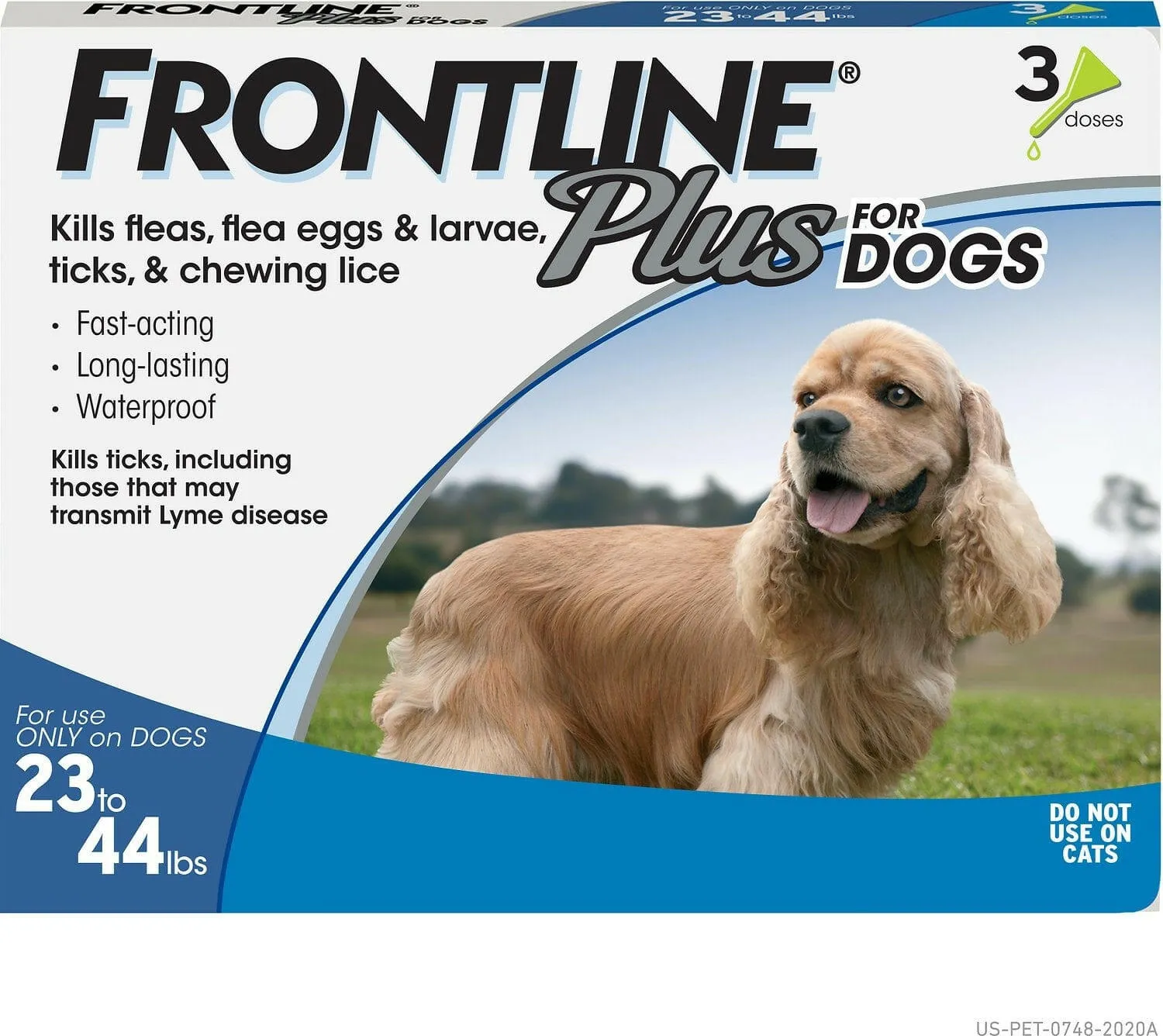 Frontline Plus for Medium Dogs (23-44 lbs) Blue Box
Frontline Plus for Medium Dogs (23-44 lbs) Blue Box
Type: Topical Spot-On
Active Ingredients: Fipronil, (S)-methoprene
Speed & Duration: Begins working within 4 hours, provides protection for 30 days.
✅ Pros:
- Kills adult fleas, flea larvae, flea eggs, and ticks, breaking the flea life cycle.
- Waterproof after 24-48 hours, making it suitable for active dogs.
- Widely trusted and recommended by veterinarians and pet parents for decades.
❌ Cons:
- May leave a slightly oily residue on the fur immediately after application.
- Some dogs with very sensitive skin might experience mild irritation at the application site.
Best For: Reliable monthly protection across all breeds and sizes, especially for routine prevention.
2. K9 Advantix II (Topical) — Multi-Threat Defense (Fleas, Ticks & Mosquitoes)
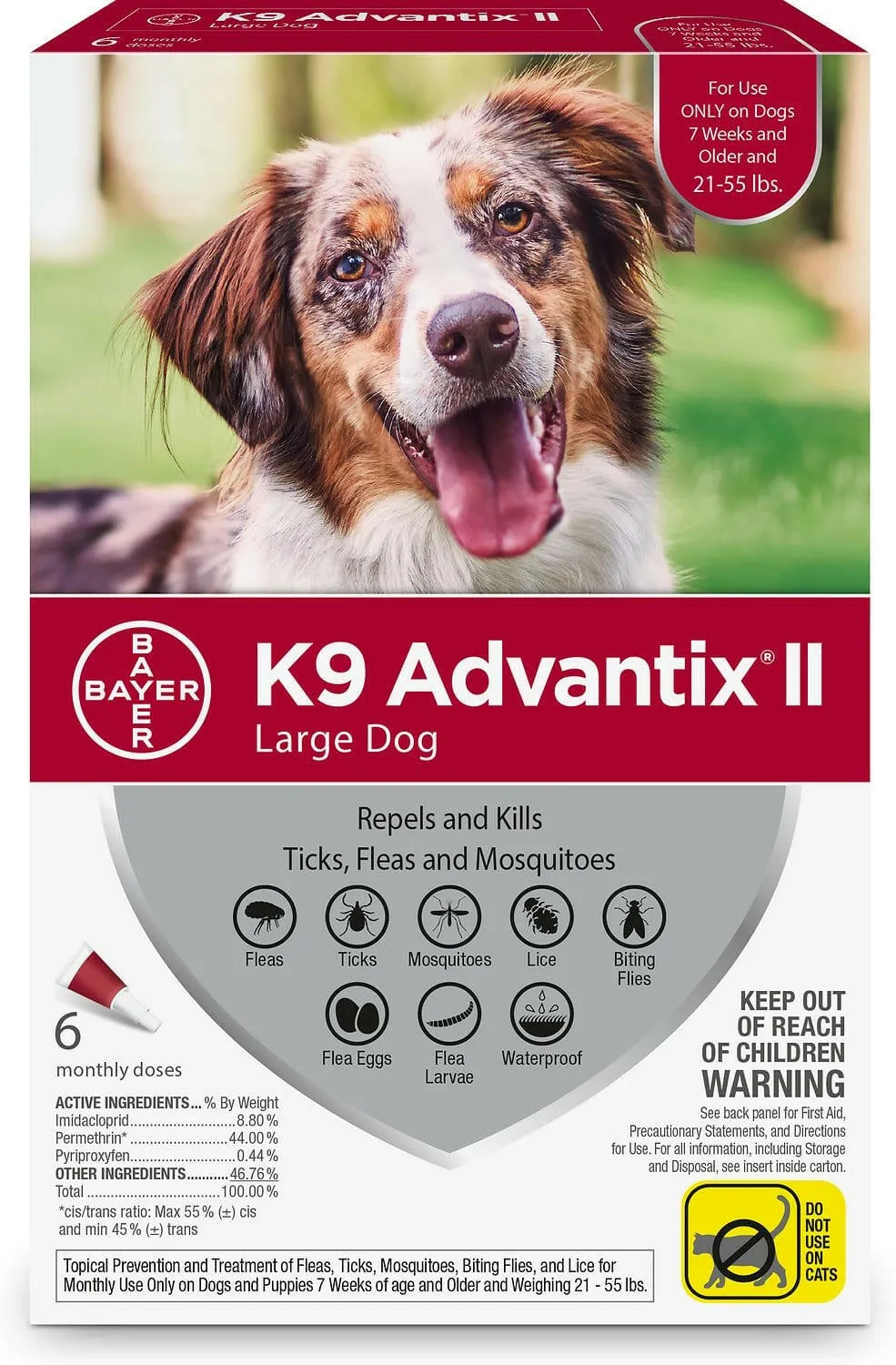 K9 Advantix II for Large Dogs (21-55 lbs) Red Box
K9 Advantix II for Large Dogs (21-55 lbs) Red Box
Type: Topical Spot-On
Active Ingredients: Imidacloprid, Permethrin
Speed & Duration: Kills fleas and ticks on contact; repels mosquitoes, providing 30 days of protection.
✅ Pros:
- Not only kills but also repels fleas, ticks, and mosquitoes, offering broad-spectrum parasite control.
- Quick absorption into the skin’s lipid layer; no flea bite is required for efficacy.
- Provides affordable multi-parasite coverage, ideal for outdoor-loving dogs.
❌ Cons:
- ⚠️ Highly toxic to cats—must be used with extreme caution in multi-pet households to prevent feline exposure.
- Permethrin can potentially irritate dogs with very sensitive skin.
Best For: Outdoor dogs and active pets in areas prone to ticks and mosquitoes, needing comprehensive protection.
3. Seresto Flea & Tick Collar — Longest-Lasting OTC Option
 Seresto Flea & Tick Collar Dog
Seresto Flea & Tick Collar Dog
Type: Collar
Active Ingredients: Imidacloprid, Flumethrin
Speed & Duration: Starts killing fleas within 24 hours and ticks within 48 hours; lasts up to 8 months.
✅ Pros:
- Offers extended protection without the need for monthly reapplications, providing great convenience.
- Non-greasy, odorless, and releases active ingredients in low, controlled doses.
- Water-resistant, maintaining effectiveness even after swimming or bathing.
❌ Cons:
- Higher initial cost compared to single-dose monthly treatments.
- Rare cases of mild skin irritation or hair loss around the neck area have been reported.
Best For: Busy owners or dogs requiring year-round, consistent protection with minimal effort.
4. Capstar (Oral Pill) — Instant Flea Kill for Emergencies
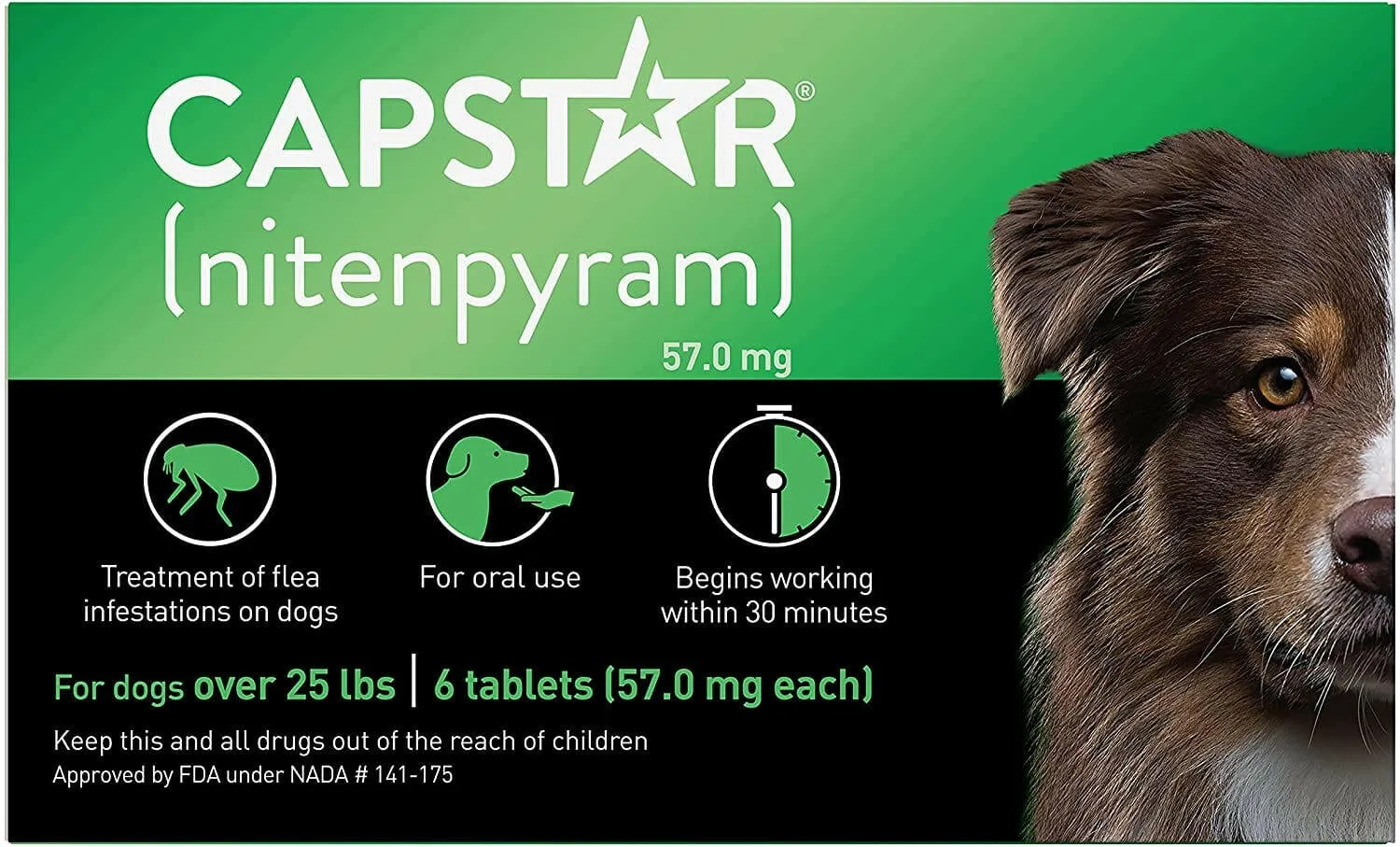 Capstar (Nitenpyram) Oral Flea Treatment for Dogs over 25 lbs
Capstar (Nitenpyram) Oral Flea Treatment for Dogs over 25 lbs
Type: Oral Pill
Active Ingredient: Nitenpyram
Speed & Duration: Begins killing fleas within 30 minutes; its effect lasts approximately 24 hours.
✅ Pros:
- Perfect for providing rapid relief during sudden, heavy infestations or before vet visits/grooming.
- Safe for puppies over 2 lbs and 4 weeks old, and for pregnant or nursing dogs.
- No messy residues, topical oils, or odors; works internally.
❌ Cons:
- Does not offer lasting protection against reinfestation; requires follow-up with a long-term treatment.
- Only kills adult fleas, not eggs, larvae, or ticks.
Best For: Fast, emergency relief during severe flea flare-ups and when quick knockdown is necessary.
5. Advantage II (Topical) — Gentle Monthly Flea Control
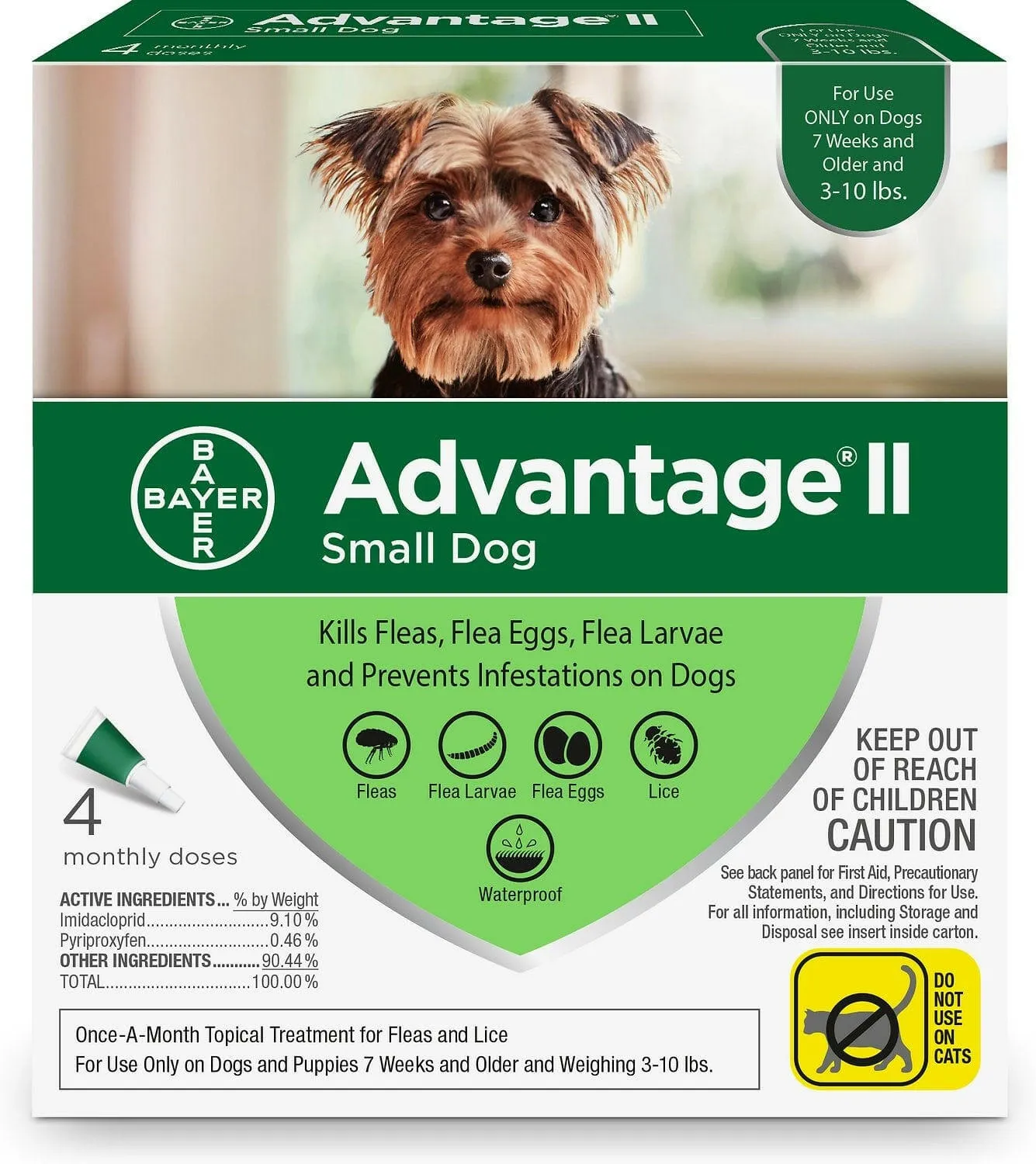 Advantage II Flea Control for Small Dogs (under 10 lbs) Green Box
Advantage II Flea Control for Small Dogs (under 10 lbs) Green Box
Type: Topical Spot-On
Active Ingredients: Imidacloprid, Pyriproxyfen
Speed & Duration: Kills fleas within 12 hours, lasts 30 days, effective against all flea life stages.
✅ Pros:
- Fragrance-free and easy to apply, making it suitable for sensitive dogs.
- Highly effective against flea eggs and larvae, disrupting the flea life cycle in the environment.
- Considered safe for households with cats, as it does not contain permethrin.
❌ Cons:
- Does not kill or repel ticks, limiting its broad-spectrum protection.
- May require careful application or brushing through for dogs with very thick coats.
Best For: Indoor dogs and homes with both dogs and cats, focusing specifically on flea control.
6. Adams Plus Flea & Tick Foaming Shampoo — Flea Relief with Skin Care
 Adams Plus Flea & Tick Foaming Shampoo & Wash for Dogs & Puppies (10 oz)
Adams Plus Flea & Tick Foaming Shampoo & Wash for Dogs & Puppies (10 oz)
Type: Shampoo
Active Ingredients: Pyrethrins, Piperonyl Butoxide, S-Methoprene, Aloe, Lanolin, Oatmeal.
Speed & Duration: Provides immediate flea, tick, and lice knockdown during the bath.
✅ Pros:
- Instantly kills fleas, ticks, and lice on contact, offering quick relief.
- Formulated with soothing ingredients like aloe, lanolin, and oatmeal to relieve irritated skin.
- Affordable and widely available, an excellent first step for heavy infestations.
❌ Cons:
- Offers only short-term protection; does not prevent future infestations.
- Not suitable for puppies under 12 weeks of age.
Best For: Immediate flea removal during bath time, soothing itchy skin, and an initial step in a comprehensive treatment plan.
7. Vet’s Best Flea & Tick Spray — Natural Flea Killer
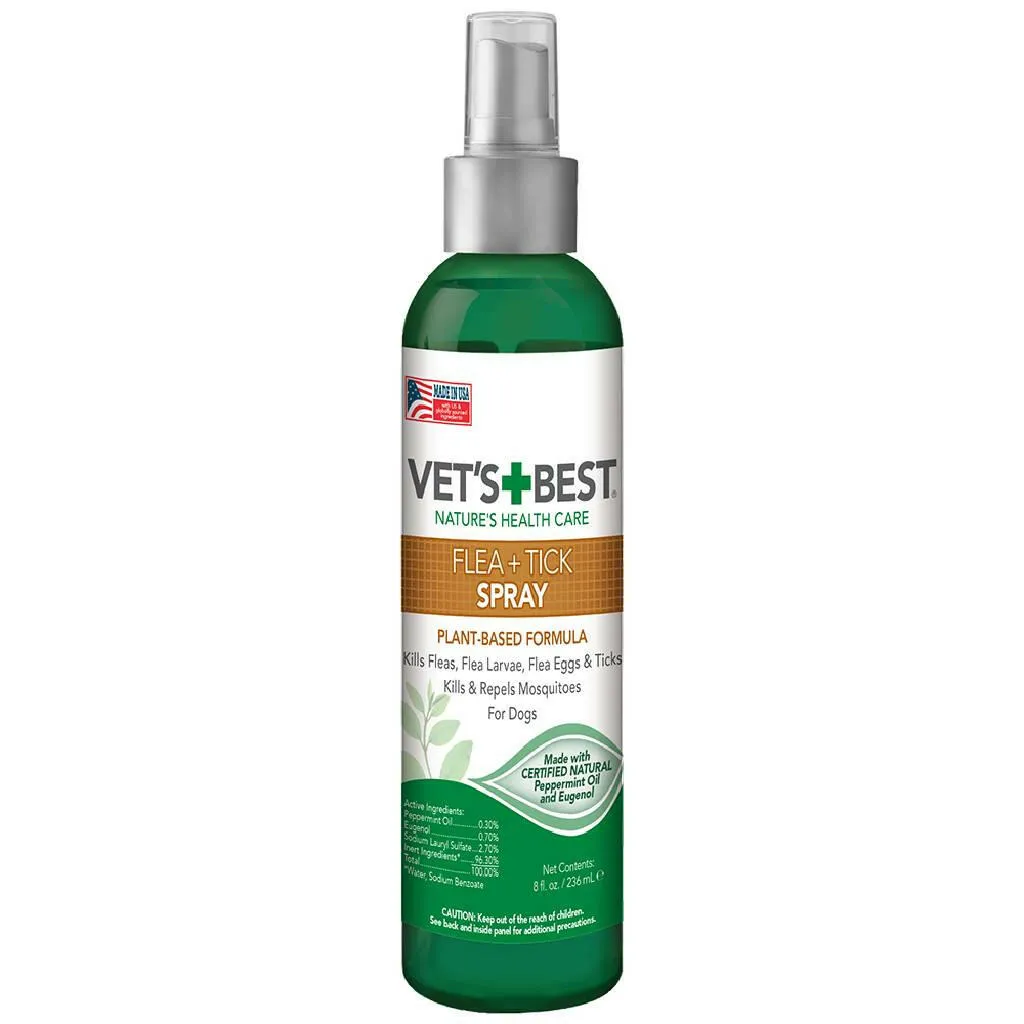 Vet
Vet
Type: Spray
Active Ingredients: Peppermint Oil, Eugenol (from Clove plants)
Speed & Duration: Kills fleas, ticks, and mosquitoes on contact; offers short-term repellent effect.
✅ Pros:
- Plant-based formula, non-toxic, and free from harsh chemicals.
- Safe for direct use on dogs (12 weeks and older), bedding, and furniture.
- Generally safe for use around children and other pets when used as directed.
❌ Cons:
- Requires frequent reapplication to maintain effectiveness, especially for active infestations.
- Can have a strong herbal scent that may linger and isn’t preferred by all users or pets.
Best For: Eco-friendly homes, dogs sensitive to chemical treatments, and as a supplementary treatment for environmental control.
8. PetArmor Plus (Topical) — Budget-Friendly Frontline Alternative
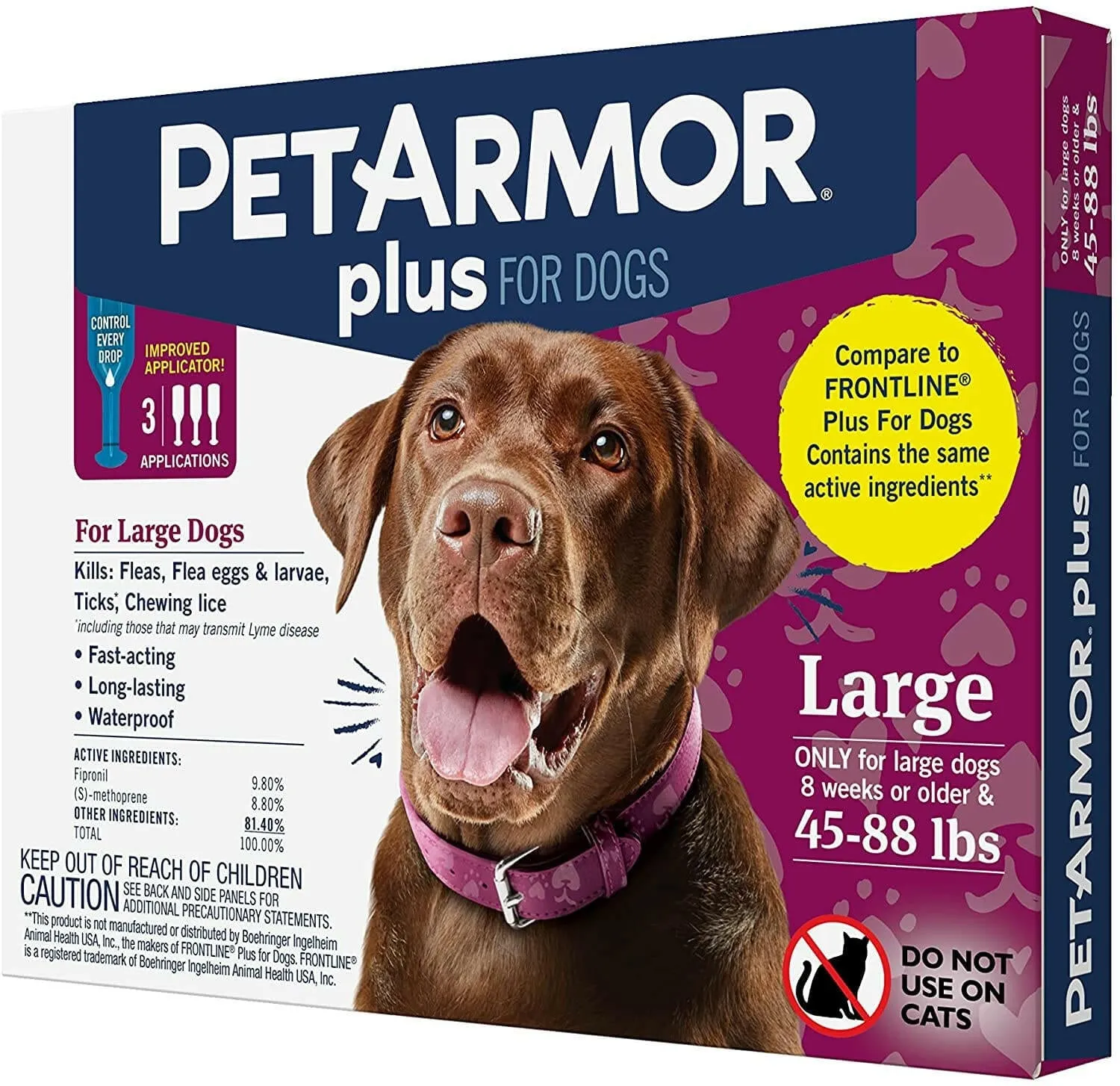 PetArmor Plus Flea & Tick Spot Treatment for Dogs, 45-88 lbs
PetArmor Plus Flea & Tick Spot Treatment for Dogs, 45-88 lbs
Type: Topical Spot-On
Active Ingredients: Fipronil, (S)-methoprene
Speed & Duration: Begins working in 12 hours, provides 30 days of protection against fleas, ticks, and chewing lice.
✅ Pros:
- Contains the same active ingredients as Frontline Plus, offering comparable efficacy at a lower price point.
- Waterproof after 24-48 hours and widely available in most pet stores and pharmacies.
- Easy to apply with convenient single-dose applicators.
❌ Cons:
- May leave a slight oily residue on the fur, similar to other fipronil-based topicals.
- While effective, some users report varying performance depending on the dog or region.
Best For: Cost-effective monthly flea and tick control for dog owners looking for a proven formula.
9. Natural Flea Collar Alternatives — Mild, Non-Toxic Repellents
 TevraPet Vetality Naturals 4 Month Flea & Tick Collar For Dogs, Large
TevraPet Vetality Naturals 4 Month Flea & Tick Collar For Dogs, Large
Type: Collar (Essential-oil-based)
Common Ingredients: Citronella, Eucalyptus, Lavender, Peppermint Oil
Speed & Duration: Begins repelling immediately; typically lasts 1–2 months (varies by product).
✅ Pros:
- Chemical-free alternative for pet owners concerned about synthetic pesticides.
- Generally safe for dogs with sensitivities or allergies to conventional treatments.
- Often leaves a pleasant, natural scent derived from essential oils.
❌ Cons:
- Not strong enough to treat active or heavy infestations; primarily for prevention or light deterrence.
- Must be replaced more frequently than standard chemical flea collars.
Best For: Maintenance and prevention in naturally sensitive dogs, or as a supplement to other environmental controls.
How Do You Choose the Right Flea Medicine for Your Dog?
With numerous flea products on the market, selecting the ideal one for your canine companion can feel overwhelming. To help you make the smartest choice, here’s a clear checklist based on your dog’s specific needs and lifestyle. When considering long-term comfort, remember that providing long-lasting dog chews for large dogs can also contribute to their overall well-being by reducing boredom and stress, which might be exacerbated by flea irritation.
- Your Dog’s Size and Weight: This is paramount. Most flea medications are precisely dosed according to your dog’s weight. Administering a treatment designed for a large dog to a small one can lead to serious toxic side effects. Always read the label and ensure you choose the correct weight category.
- Age and Health Status: Puppies, pregnant or nursing dogs, senior pets, or those with underlying health conditions (e.g., epilepsy, skin sensitivities) may require specially formulated or vet-approved treatments. For example, Capstar is generally safe for puppies over 4 weeks and 2 lbs, but many topical treatments have an age restriction of 8 weeks or older. Consult a vet if unsure.
- Type of Infestation: Is it a light, seasonal issue, a sudden new outbreak, or a heavy, recurring problem? For immediate, emergency flea kill, an oral pill like Capstar is excellent. For sustained, long-term protection against chronic cases, a Seresto collar or monthly topical like Frontline Plus would be more appropriate.
- Lifestyle & Environment: Dogs that spend significant time outdoors or in areas with high tick/mosquito populations may benefit from multi-threat options like K9 Advantix II, which not only kills but also repels these parasites. For indoor-only dogs, a flea-specific product like Advantage II might suffice.
- Household Composition: If you have cats, it is absolutely critical to avoid treatments containing permethrin (such as K9 Advantix II). Permethrin is highly toxic and potentially deadly to felines, even through indirect contact. Opt for permethrin-free options like Advantage II or oral treatments.
- Application Preference: Consider what is easiest and safest for you and your dog. Oral tablets (Capstar) offer no mess. Topical spot-ons (Frontline Plus) are applied monthly. Collars (Seresto) provide “set-it-and-forget-it” convenience for several months. Shampoos and sprays offer immediate relief but are short-term.
By carefully considering these factors, you can confidently select the best flea treatment for dogs without a vet prescription that genuinely meets your dog’s unique needs and ensures their comfort and health.
How to Use Flea Medicine Safely Without a Prescription
Over-the-counter does not mean risk-free. While OTC flea medicines are widely available and highly effective, they must be used responsibly and precisely to protect your dog’s health. Here’s how to ensure safe and effective use:
- Always read and follow the label directions meticulously. Each product comes with specific usage instructions based on your dog’s size, age, and health status. Never guess the dose or application method—adhere to the label exactly. This is crucial for efficacy and safety.
- Use the correct product for your dog’s weight and age. Giving a product designed for a large dog to a small pup, or vice versa, can lead to dangerous under-dosing or overdosing. Puppies, senior dogs, and those with existing health conditions may require vet-approved alternatives or specific formulations.
- Avoid mixing flea products. Do not use multiple types of treatments simultaneously (e.g., a topical spot-on and a flea collar) unless specifically recommended and monitored by your veterinarian. Excessive exposure to active ingredients can be harmful and potentially lead to toxicity.
- Monitor your pet closely for any side effects. After applying or administering flea medication, watch for unusual signs such as excessive drooling, vomiting, diarrhea, lethargy, loss of appetite, shaking, or severe skin irritation (redness, itching, swelling) at the application site. If any of these symptoms appear, contact your vet immediately.
- Be mindful of other pets in your household. Some dog flea products—particularly those containing permethrin (like K9 Advantix II)—are extremely toxic to cats. Ensure cats do not come into contact with treated dogs until the product has fully dried. Separate pets as needed.
- Store treatments safely and out of reach. Keep all flea medications securely stored away from pets and children. Store them in a cool, dry place as directed on the packaging to maintain their potency and prevent accidental ingestion.
- Maintain consistency with your treatment schedule. Apply or administer flea treatments on schedule—whether that’s daily, monthly, or seasonally. Skipping doses can leave your pet vulnerable to reinfestation and break the critical flea life cycle control.
Used properly, OTC flea medicine is both safe and remarkably effective in controlling fleas. To further support your dog’s well-being and alleviate any discomfort or stress from itching, consider providing them with safe and good things for dogs to chew on, which can offer a healthy distraction. Up next: how to enhance your flea treatment efforts with proactive environmental care.
How Can You Improve Flea Control Beyond Just Medication?
Treating your dog is only part of the solution. To fully eliminate fleas and prevent them from returning, you must address your pet’s entire environment. Fleas spend most of their life cycle (eggs, larvae, pupae) off the host, in your home and yard. Here are some proven tips that work synergistically with flea medications:
- Groom your dog regularly: Frequent brushing helps you spot fleas early and removes dead skin cells, flea eggs, and flea dirt from their coat. Use a fine-toothed flea comb to target common problem areas like the neck, back, and base of the tail. Regular grooming also promotes a healthy coat.
- Bathe your pet when needed: While not a long-term solution, flea shampoos can provide immediate knockdown, physically removing fleas, especially during the initial stages of an infestation. Even regular bathing with a mild dog shampoo helps wash away flea dirt and some adult fleas, contributing to overall cleanliness.
- Clean your home thoroughly and consistently: Vacuum carpets, rugs, upholstery, and furniture frequently—especially in areas where your dog rests or sleeps. The vibrations from vacuuming can also encourage flea pupae to hatch, making them more susceptible to treatment. Immediately dispose of the vacuum bag outdoors after use.
- Wash pet bedding in hot water weekly: Flea eggs and larvae thrive in pet bedding. Washing all bedding (dog beds, blankets, pillows) in hot water (at least 140°F or 60°C) and drying it on the highest heat setting will effectively kill all flea life stages.
- Treat your home and yard strategically: Use pet-safe flea sprays, powders, or foggers designed for indoor areas. Always follow label directions closely. Outdoors, keep your lawn trimmed, remove leaf piles, and eliminate debris where fleas thrive, especially in shady, moist areas. Consider professional pest control for severe yard infestations.
- Use flea preventatives year-round: Many people mistakenly believe fleas are only a problem in summer. However, indoor heating can keep fleas active all year, making your home a perfect breeding ground. Maintain your dog’s flea medication schedule consistently, even during winter months, for continuous protection.
- Limit exposure to untreated pets: Fleas can easily hitch a ride from other animals. If your dog frequently interacts with other pets, ensure those animals are also on a proper flea prevention plan to minimize the risk of reinfestation.
By combining the best flea treatment for dogs without a vet prescription with consistent and thorough home care, you dramatically reduce the chance of reinfestation, keeping your dog comfortable, protected, and your home flea-free. For playful pups, ensuring they have the best chew bone for a puppy can also help redirect their energy and soothe any mild irritation they might still experience.
Are Over-the-Counter Flea Medicines Safe for Dogs?
Yes, most over-the-counter (OTC) flea treatments are generally safe and effective when used correctly according to their label instructions. However, like any medication, they can cause side effects, especially if the dosage is incorrect, if the product is misused, or if your dog has particular sensitivities or underlying health conditions.
Common Side Effects
It’s important to be aware of potential reactions:
- Topical Treatments: The most common side effects include skin irritation, redness, itching, or temporary hair loss at the application site. Some dogs might experience a temporary oily residue.
- Oral Medications: Less common, but can include mild gastrointestinal upset such as vomiting, diarrhea, or a temporary decrease in appetite.
- Flea Collars: Rarely, some dogs may exhibit mild itchiness, redness, or discomfort around the neck area where the collar sits.
Always follow the weight and age guidelines listed on the packaging without exception. For instance, many topical treatments are specifically not safe for puppies under 8 weeks of age and should never be used on them.
Special Precautions
- Never use cat flea products on dogs, or vice versa. Ingredients that are safe for dogs can be highly toxic and even deadly to cats (e.g., permethrin). Always ensure you are using a product specifically formulated for dogs and the correct species.
- Avoid mixing treatments unless explicitly directed by a veterinarian. For example, combining a spot-on treatment with a flea collar could lead to an overdose of active ingredients, resulting in severe adverse reactions.
- Monitor your dog closely after the first use. This is especially important for new products. Watch for any unusual behavior or physical symptoms like excessive scratching, lethargy, restlessness, or vomiting. If you observe concerning signs, contact your vet immediately.
When used responsibly and according to instructions, OTC flea medicine is a valuable and safe tool for flea management.
When Should You See a Vet Even If Using OTC Flea Products?
While over-the-counter flea treatments are excellent for prevention and managing mild to moderate infestations, there are specific situations where professional veterinary care is absolutely essential. Recognizing these signs can save your dog from prolonged discomfort or serious health complications.
- Severe infestations that don’t improve or recur frequently. If despite consistent use of the best flea treatment for dogs without a vet prescription and thorough environmental control, fleas continue to plague your dog or home, it might signal a resistant strain of fleas, an overwhelming environmental source, or an underlying issue. A vet can prescribe stronger, prescription-grade treatments or combination therapies to effectively break the cycle.
- Signs of allergic reactions or severe side effects to medication. Watch for symptoms such as excessive drooling, persistent vomiting or diarrhea, muscle tremors, seizures, severe skin irritation (beyond mild redness), swelling, or noticeable behavioral changes (e.g., extreme lethargy or hyperactivity). These may indicate a toxic reaction to the medication that requires immediate veterinary attention.
- Flea-borne illnesses or secondary skin infections. Fleas can transmit diseases like tapeworms and Bartonellosis (cat scratch disease). Constant scratching can also lead to open wounds and bacterial skin infections, which often require antibiotics. If your dog is losing fur in patches, developing scabs, has a dull coat, seems unusually lethargic, or is exhibiting other signs of illness, do not wait—seek veterinary care promptly.
- High-risk pets (puppies, seniors, pregnant/nursing dogs, or chronically ill dogs). These groups are often more vulnerable to the effects of fleas and may not tolerate many OTC treatments well. Their developing immune systems, compromised health, or delicate states often require customized, lower-dose, or prescription-only solutions to ensure their safety and effectiveness.
- You’re unsure what product to choose or how to use it safely. The sheer number of flea products can be overwhelming. If you’re confused about which product is safest for your dog’s specific needs (e.g., breed sensitivities, existing conditions) or how to apply it correctly, a quick consultation with your vet can provide clarity, prevent errors, and save you time, money, and stress in the long run.
Remember: while OTC flea medicine is an excellent tool in your pet care arsenal, your veterinarian remains your best resource for complex cases, health-sensitive pets, or any situation where you are uncertain about your dog’s health.
Final Thoughts on Choosing Flea Medicines Without a Vet Prescription
Fleas are more than just a nuisance—they pose a significant health risk for your dog and can be a persistent headache for pet owners. Thankfully, the availability of over-the-counter flea medicines empowers you to effectively fight back without always needing a vet prescription. Whether you opt for a convenient monthly topical, a fast-acting oral pill for emergencies, or a long-lasting collar, there are numerous effective and affordable options to fit nearly every lifestyle and need.
That said, the key to lasting success in flea control goes beyond simply picking the right product. It’s about using it correctly, staying consistent with your treatment schedule, and combining medication with smart, proactive home hygiene practices. From regular grooming and bathing to thorough cleaning of your home and yard, every step counts in keeping fleas away for good. For ensuring your dog’s comfort and well-being, especially during times of recovery or stress, remember to also consider practical items like long-lasting dog chews for large dogs or appropriate chew toys for smaller breeds, which can provide mental stimulation and physical relief.
And always remember—while OTC solutions are powerful and highly effective for routine management, your veterinarian is always a crucial resource if infestations become severe, if your dog experiences adverse reactions, or if your pet has special health needs that require tailored advice.
With the right strategy and a little help from trusted pet care resources, your dog can stay happy, healthy, and flea-free all year long.
OTC Flea Medicine for Dogs FAQs
Can I use flea medicine for dogs on puppies under 8 weeks old?
No, most OTC flea medicines are not safe for puppies under 8 weeks of age. Products designed for adult dogs can be toxic to very young puppies due to their developing systems and lower body weight. Always check the age and weight requirements on the label, or consult a veterinarian before applying any treatment to very young dogs to avoid toxicity or adverse reactions.
What should I do if my dog licks the flea treatment?
If your dog licks a topical flea product after application, monitor them closely for symptoms such as excessive drooling, vomiting, diarrhea, lethargy, or behavioral changes. Many topical products contain bittering agents to deter licking, but ingestion can still cause side effects. Contact your veterinarian for guidance, as the severity of the reaction can depend on the specific product and amount ingested.
How long after applying flea medicine can I bathe my dog?
Most topical flea treatments require a waiting period of 24 to 48 hours (and sometimes longer) after application before bathing your dog. This waiting time allows the product to fully spread across the skin and absorb effectively. Bathing too soon may wash away the active ingredients and reduce the product’s effectiveness. Always refer to the specific product’s instructions for the exact recommended wait time.
Can I use OTC flea treatments year-round?
Yes, year-round flea prevention is highly recommended, especially in warmer climates where fleas are active all year, or in homes with central heating, which can create ideal conditions for fleas even in winter. Continuous protection helps break the flea life cycle and prevents reinfestation in your home and on your pet.
What if my dog has fleas but no itching?
It’s possible for a dog to have fleas without showing obvious signs of itching. Some dogs are less sensitive to flea bites, or the infestation might be very light. However, fleas can still lead to health issues like anemia or tapeworm transmission even without visible discomfort. If you spot fleas or flea dirt during routine grooming, treat immediately, even if your dog isn’t scratching. Regular checks are key to early detection and effective control.
